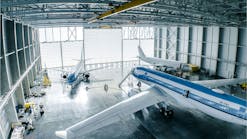How Nairobi's JKIA is gearing up to be Africa's premier aviation hub, reports Denis Maina Gathanju.
May 2004
Recent renovation works at Nairobi's Jomo Kenyatta International Airport (JKIA) have set the pace for the development of the airport as Africa's aviation hub. The Kenyan government in conjunction with the World Bank are financing the Kes 3b project.
The Kenyan government will provide twenty five percent of the total cost while the World Bank will bankroll the remainder under the Northern Corridor Transport Improvement Project (NCTIP). The NCTIP involves the World Bank and the governments of both developed and developing countries with aims at helping the latter improve their ports, road networks and airports.
"JKIA needs to be remodeled to meet international security standards, which will facilitate direct flights between Kenya and the United Sates and partnerships or code sharing with other international airlines," said the World Bank country representative Mr. Makhtar Diop. According to the Managing Director of the Kenya Airports Authority Mr. George Muhoho, the funds will be used to expand the capacity at the Old Embakasi Airport and restructure Unit 3 at JKIA for international passengers.
Restructure Signifies Growth The Old Embakasi Airport is currently a military base and a training college for the Kenya Air Force while Unit 3 at JKIA for domestic arrivals and departures. The restructuring of Unit 3 will bring on boardanother one million passengers at the airport and a further one million passengers will be passed through the airport on completion of a new Unit 4. This will increase the airport's capacity to between five and seven million passengers per annum. According to the Deputy Managing Director of the Kenya Airports Authority Mr. Kabiru, JKIA is still in the leading airport in the region. He stated, "Addis Ababa Airport in Ethiopia has just put up a new terminal and it will be of no match to JKIA when we put up Unit 4, restructure Unit 3 for international passengers and construct another runway parallel to the existing one."
Once the expansion is complete, JKIA will attain a "Category I" status so that planes can fly directly to US airports. "JKIA has to attain a Category I status set by the US Federal Aviation Authority (FAA) to be given landing rights in America. It will promote investment and tourism in the country," said Transport and Communication Minister Mr. John Michuki.
The national carrier, Kenya Airways (KQ) has been unable to form a code sharing partnership with Northwest Airlines of the US because JKIA has not attained Category I status. Kenya Airways has a code-sharing agreement with KLM the Royal Dutch carrier, which has similar partnership with Northwest Airlines. "Definitely there is a new sense of urgency at JKIA, from aircraft cleaners to baggage handlers. JKIA is today not what it was five, six years ago; but there is still a long way to go," said KLM vice-president and area manager for Africa Ron Schipper.
Not only are airline managers complaining of congestion and inadequate facilities, passengers on transit are becoming increasingly edgy. "JKIA is terribly constrained by space. The airport has a capacity of 2.5 million passengers per annum but it is now accommodating 3.2 million passengers," Muhoho said.
Epicenter of Growth Strategy
The strategy to turn JKIA into a hub was mooted soon after Kenya Airways and
KLM signed a partnership agreement in 1996. Kenya Airways is staking its future
profitably on the improvement of JKIA to a world-class status and has invested
some Kes 228 million in this pursuit. Kenya Airways requires a better airport
to buttress its marketing strategy of developing Nairobi as the epicenter
of air travel in the region. "The airport is the epicenter of our growth
strategy. We have to make our home base the premier continental hub offering
facilities and services comparable to the best in the world," said Kenya
Airways Chairman Mr. Isaac Omolo Okero.
Kenya Airways' investment in the so-called hub concept is in tandem with a global trend that has seen several airlines go back to the development and market positioning their home based as the ultimate destination, a terms of service and onward connections.
This is what Kenya airways' strategic partner KLM has done with Schipol Airport, Amsterdam and British Airways with London Heathrow. And from the small print of the results, it would seem that "Nairobi as a hub" strategy is starting to bring home the pork. Kenya Airways has become the market leader on the route between Kenya and Europe.
A Welcome Boost
Kenya lies strategically across the Equator and on the eastern coast of Africa making it a viable transit point to Europe, Southern Africa, West Africa, the Middle East and Asian routes. According to KQ Chairman, Mr. Omolo Okero, the airline handles 70 percent of all passenger traffic at JKIA. The Nairobi Cargo Handling center is a welcome boost for the JKIA. The 11,700-square-meter facility can handle 97,000 tonnes while operating at maximum capacity.
The venture to put up the Kes 1.5 billion facility at JKIA was mooted in 1997 to provide efficient, high quality and competitive ramp services, cargo handling, logistics and other airport related services at JKIA. According to the Transport Minister Mr. Michuki, the program will also involve increasing capacity of the port so that it can handle cargo not just for Kenya, but the entire region.
The port has a capacity to handle 22 million tonnes annually, but has been handling less than half the capacity. Private operators handle currently over sixty percent of the non-containerized traffic at the airport.
Rail Service - Part of the Plan The Kenya Railways Corporation (KR) is carrying out a survey between Nairobi's main railway stationand Jomo Kenyatta International Airport (JKIA) as part of a plan to set a rail service between Nairobi and the airport. Planning officials at KR said recently that they were evaluating plans to either connect JKIA to the old Embakasi airport, which has a rail connection to the city, or to build a new and direct railway line from JKIA to the Nairobi Railway station.
Although an extension from Embakasi will be cheaper, a direct line to the city would be more appropriate, depending on the kind of trains envisaged, KR planners said. George Muhoho, the managing director of the Kenya Airports Authority (KAA) said earlier that a joint KR-KAA planning team had finalized a preliminary study on the project, but a more technical report is expected later.
According to Mr. Muhoho, KAA is also negotiating with the Roads and Public Works Ministry to make the North Airport Road a dual carriageway complete with two flyovers, and to construct another dual carriage on the Outer Ring Road's approach to JKIA. He said that although JKIA's $53 million expansion project was ready to take off, there had been increasing concern over traffic congestion between the airport and the city center. According to the Deputy Managing Director of KAA, Mr. Dominic Kabiru, there are also security concerns at the airport over the fact that arriving and departing passengers are not separated as they mingle in the lobbies and lounges.
Connection to the World
As the home base concept takes root a Kenya Airways (KQ), with a vision to
becoming a world class airline by 2005, the expansion programme at JKIA starts
in earnest. The strategy is to create a world-class African airline and an
African aviation hub, where the world connects with Africa and truly, The
Pride of Africa.









